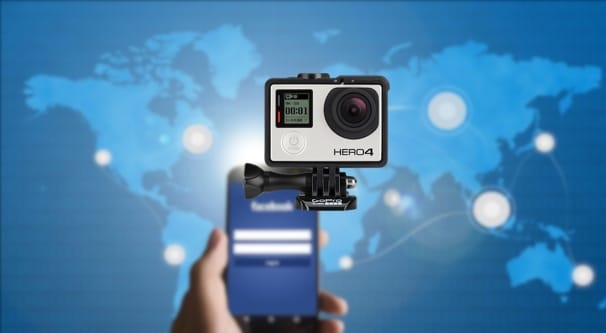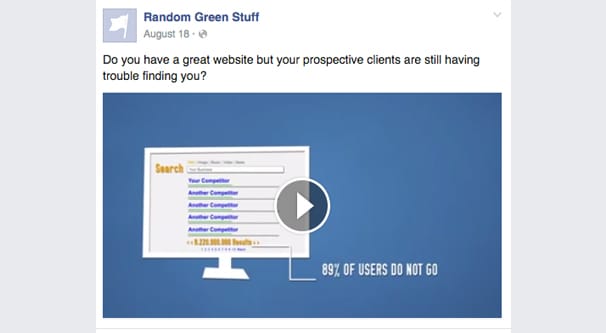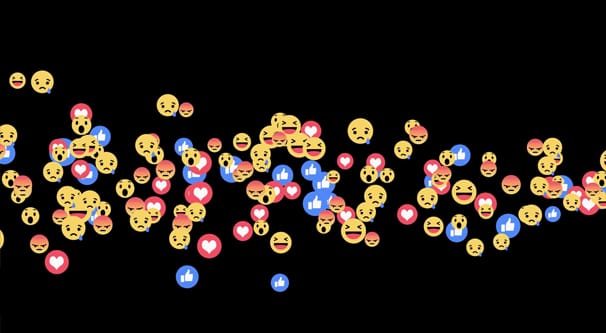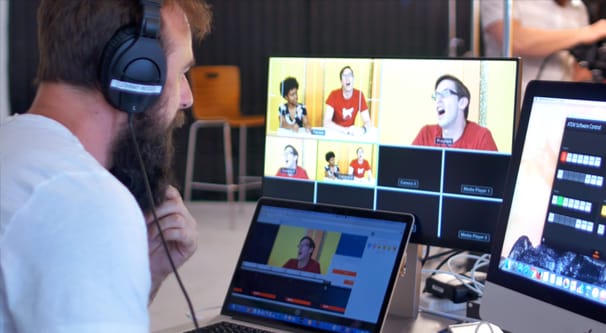 Written by ContentPowered.com
Written by ContentPowered.com
It’s no secret that different kinds of content have different levels of reach in the Facebook news feed. The algorithm, colloquially known as EdgeRank, includes the type of post as one of its weighting factors.
As you might imagine, this is rampantly abused by pages that just want clicks so they can get eyes on their page. These pages don’t usually have anything worthwhile to share, they just want as broad a userbase as possible so they can sell sponsored posts and get clicks on their affiliate links.
Which post types rank at the top, and where do live stream videos fit into it all?
Facebook Post Types
There are actually not very many types of posts on Facebook. For all that the typical news feed looks like a series of brightly colored and widely varied boxes of information, there aren’t really too many discrete types of posts. You have:
Standard text posts. These are the absolute most basic types of posts on Facebook, where you type in the post box and hit submit. They’re also the least weighted because they have the least engagement to them. When 99% of the posts in a news feed have some kind of image or video attached to them, one that doesn’t even have color to it is easy to ignore.
Colored text posts. Facebook introduced this feature a while back, to make basic text posts look better. When you go to create a post you see a bunch of colored circles, some with patterns. When you choose one of those, your text post becomes an image with your text on top of a square background of the color you chose. It makes a post look like an image without needing to actually make an image, and thus has higher engagement and reach.
Link preview posts. Almost every time you post a link on Facebook, a preview is generated based on the open graph tags on that page, or on meta data if no such graph attributes exist. The link preview is one of the most common Facebook post types. It has more reach than a basic text post, but not by a lot; you can consider it something of a baseline.
Sponsored posts. I’m including sponsored posts here because most of them are just link preview posts, but they can actually be just about any post type. The reach they give you shouldn’t be considered, though, because it depends heavily on your targeting and your budget.
Single image posts. Image posts come in a lot of different forms. They’re all generally going to give you a bit more reach than a link post, but with variations between each type. A single image post is just that; an image with a caption, some tags, and maybe some other photo meta data.
Photo album posts. There are several ways to post multiple images at once. Usually you see photo albums; displayed as three images with a number over the third, indicating how many more images are in the album. You might also see a photo carousel, with one image side by side with half of another, indicating a slideshow of sorts. These are usually used for photo ads.
Video posts. Videos that you upload to Facebook are given more reach than almost any other kind of post, specifically because they’ve been fighting to take a spot as one of the top video hosting sites online. They’ve even beat out YouTube by some metrics, though frankly using Facebook to browse videos is a very different experience than using YouTube for it.
Live stream video feeds. When Facebook decided it was “good enough” with its video positioning, it decided to push video livestreaming in competition with YouTube streaming and Twitch.tv, among other services. Thus, as they try to compete, Facebook has been giving live stream videos much more exposure and preference in their news feed.
Notes and Amp articles. I’m including these at the end as a special case. Note posts are almost dead as a form of posting, while Amp articles are thriving among certain circles. Some pages use them, others don’t; they appear differently in the news feed, but are not really very common unless you follow those specific types of pages. They’re unique, in any case.
Live Video Abuse
As you might imagine, as Facebook gives preferential reach to live videos, many pages have decided to start using them. The same thing happened with static videos.
What do I mean? Well, think back to about this time last year. Did you ever see someone on Facebook share what looked like an image post, but with a big play button on it? You might not have even noticed it, unless you noticed that the image had playback controls. Often times this was just a screenshot of a meme or something equally insipid. No sound, no animation, just an image post formatted as a video.
The reason pages did this is, all else being equal, an image post gets less reach than a video post, even if the video is just that static image. Many people didn’t even notice the difference, and when people did, well. If someone makes a comment calling you out on it being a video, that’s still a comment and it still gives the post more shared reach. It’s a win/win all around.
Of course, Facebook didn’t like this abuse of their system, so they eventually cracked down on it. In the middle of last year, they started up an algorithmic scanner that checks videos when they’re uploaded. If that video is just a static image and there’s no relevant audio to go along with it, Facebook would demote it to about the same reach as an image post, if not a bit lower.
This also applies to videos that have some basic animation, but not anything really useful. One prime example is a countdown timer; it doesn’t add anything to the fact that it’s a video, so it gets a bit demoted.
With the demotion of static videos, many pages abusing them stopped doing so, though it still happens. Most of those pages, though, jumped on the Facebook Live bandwagon almost immediately. Facebook has been pushing livestreaming, and as such, Facebook Live videos get preferential treatment in the news feed. That means these spammy, low quality pages are using Facebook Live videos the way they did static videos in the past.
One variation that was very common for about a year was the “like stream” video. The idea is that you have one live video feed linked to an API from Facebook. You’ll have a counter for each type of reaction – likes, loves, angry faces, etc – and an associated image for each. Essentially, you would vote for whichever one you preferred by using your reaction.
The Live video is static except for the display of the reactions. The reactions, meanwhile, are engagement on the video and further promote it throughout news feeds on Facebook. It’s spammy and abusive of the system, and Facebook has started cracking down on it.
When you set up a Live Video stream now, Facebook warns you not to use reactions in an inappropriate way. You can’t use them as a voting mechanism, as a representation of an object, as a limitation, or as an influence on the video. Basically, Facebook is telling you not to use reactions as an element of the video.
So, to answer the question in the title, no. Facebook like stream videos are being demoted by Facebook’s algorithm after widespread abuse.
Facebook live videos were also often used in the same way as static videos; a static image, broadcast “live”, in order to get that sweet expanded news feed reach. Facebook knows all about this, obviously, though they didn’t think to proactively fight against it.
As things stand today, it’s a bit of an arms race. Facebook is demoting Live videos with static images as their only content. In order to fight against that, a lot of “content” producers are using floating triangles that move across the screen and other minor animation variants to spoof the algorithm. Facebook’s machine isn’t bright enough to tell the difference between genuinely animated content and content with fake animation like those triangles. Thus, those Live videos are not actively demoted, yet.
Facebook’s algorithm is powered by some level of machine learning, which means eventually it will be able to determine when a video is spoofing motion in this or similar ways. On the other hand, as long as Facebook is promoting Live videos above and beyond other forms of content, there will be pages trying to abuse them.
Using Live Videos Properly
If you want to take advantage of Live videos and their associated boost in reach, you certainly can. You just can’t do it by using static images, with or without algorithm-baffling filters.
What you should do is create genuine content. What that content is depends on your brand. You might essentially just broadcast TV commercials in sequence. You might set up a tech demo, a small personal conference, a skit, or a behind the scenes tour of your company. You might set up a Q&A webinar. You can do all of the above, testing to see which ones your audience reacts the best to.
If you’re going to livestream anything on Facebook, I recommend as close to a professional setup as possible. Don’t just use a webcam; use a professional-grade camera hooked up to your computer. If you’re broadcasting a screen feed instead, use a high quality image capture, like OBS, XSplit, or Wirecast. Make sure you have a high quality audio feed as well! If anyone is tuning into your live videos, you want them to have reasonable volume, high quality audio. Get a pop filter and do some audio processing if possible, to minimize noise, stutter, and other problems.
Also, make sure you test your livestream in a limited environment before you actually go live. Most livestreaming apps will allow you to capture a video without actually streaming it; save a video as a test run and play it back to see how it looks and sounds. This doesn’t take into account the Facebook processing necessary to broadcast on the site, but it will allow you to diagnose audio issues and familiarize you with the software before you have to troubleshoot live.
You will also need to have a strong internet connection before you go live. If you go to a speedtest site, you’ll want at least 10mb upload. Anything less means complicated HD video is likely to stutter, drop frames, or lose bitrate. Make sure you’re on at least a 4G connection if streaming via cell service on a mobile device. More is always better; connection usage can affect video quality, and you don’t want a drop in quality in the middle of your broadcast.
From there, success will usually rely on the typical promotional techniques. Plan your live video session in advance and post about it to build hype, the same way you would any content announcement. When broadcasting, watch your live chat and engage with the people watching. Respond to comments and thank commenters when they engage with your stream. You can build relationships this way, and get dedicated fans.
Facebook, of course, also recommends streaming on a regular basis to build a regular audience. When people know you and regularly engage with you, they’ll tune in more often and share your feed more often, building better engagement.





